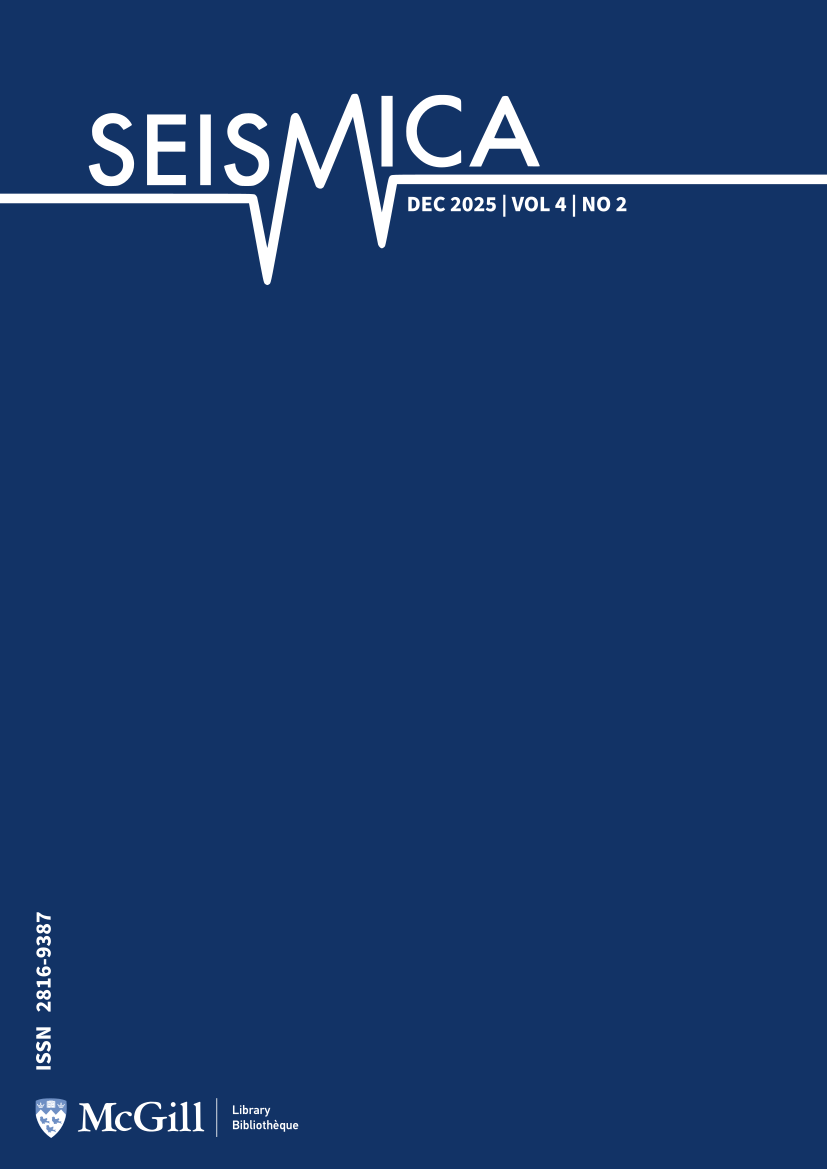Supershear-subshear-supershear rupture sequence during the 2025 Mandalay Earthquake in Myanmar
DOI:
https://doi.org/10.26443/seismica.v4i2.1785Abstract
We investigated the rupture dynamics of the 2025 Mw 7.7 Mandalay, Myanmar earthquake, using a video recording of surface rupture, strong motion recordings, waveform simulation, and satellite imagery. Our assessment, based on the S-wave observation in the video and rupture arrival time at a seismic station 246 km south of the hypocenter, suggests that rupture decelerated to subshear speeds (~3 km/s) from initial supershear propagation (~6 km/s) before reaching the camera location. This deceleration is also supported by comparison between the fault-normal acceleration patterns seen in the video and that simulated by kinematic rupture modeling. Additionally, satellite imagery indicated a local minimum in slip (2-3 m) approximately 40-60 km south of the epicenter, suggesting a region of reduced stress drop that likely caused the temporary deceleration. Beyond this point, the rupture appears to have re-established supershear propagation.
References
Abdelmeguid, M., Elbanna, A., & Rosakis, A. (2024). Ground motion characteristics of subshear and supershear ruptures in the presence of sediment layers. Geophysical Journal International, 240(2), 967–987. https://doi.org/10.1093/gji/ggae422 DOI: https://doi.org/10.1093/gji/ggae422
Andrews, D. J. (1980). A stochastic fault model: 1. Static case. J. Geophys. Res., 85(B7), 3867–3877. https://doi.org/https://doi.org/10.1029/JB085iB07p03867 DOI: https://doi.org/10.1029/JB085iB07p03867
Andrews, D. J., & Barall, M. (2011). Specifying initial stress for dynamic heterogeneous earthquake source models. Bull. Seismol. Soc. Am., 101(5), 2408–2417. https://doi.org/https://doi.org/10.1785/0120110012 DOI: https://doi.org/10.1785/0120110012
Dunham, E. M., & Archuleta, R. J. (2005). Near‐source ground motion from steady state dynamic rupture pulses. Geophysical Research Letters, 32(3). https://doi.org/10.1029/2004gl021793 DOI: https://doi.org/10.1029/2004GL021793
Freund, L. B. (1990). Dynamic Fracture Mechanics. Cambridge University Press. DOI: https://doi.org/10.1017/CBO9780511546761
Fukuyama, E., & Mikumo, T. (2007). Slip-weakening distance estimated at near-fault stations. Geophysical Research Letters, 34(9). https://doi.org/10.1029/2006GL029203 DOI: https://doi.org/10.1029/2006GL029203
Gao, J., Zheng, F., Wang, C., & Meng, H. (2025). Video-based Direct Time Series Measurement of Along-Strike Slip on the Coseismic Surface Rupture During the 2025 Mw7.7 Myanmar Earthquake. arXiv. https://doi.org/10.48550/ARXIV.2505.20494
Hirano, S. (2025). 2-D Boundary Element Method with a flat fault [Software]. OSF. https://doi.org/https://doi.org/10.17605/OSF.IO/MTR76
Hirano, Shiro. (13 May 2025, 5:11 pm). @Bimaterial. “I analyzed the distance between two edges in the video during surface rupture due to the M7.7 Myanmar earthquake.” [Tweet]. X. https://x.com/Bimaterial/status/1922157655641952512
Hurukawa, N., & Maung Maung, P. (2011). Two seismic gaps on the Sagaing Fault, Myanmar, derived from relocation of historical earthquakes since 1918. Geophysical Research Letters, 38(1). https://doi.org/https://doi.org/10.1029/2010GL046099 DOI: https://doi.org/10.1029/2010GL046099
Inoue, N., Yamaguchi, R., Yagi, Y., Okuwaki, R., Bogdan, E., & Tadapansawut, T. (2025). A multiple asymmetric bilateral rupture sequence derived from the peculiar tele-seismic P-waves of the 2025 Mandalay, Myanmar earthquake. Seismica, 4(1). https://doi.org/10.26443/seismica.v4i1.1691 DOI: https://doi.org/10.26443/seismica.v4i1.1691
Kearse, J., & Kaneko, Y. (2025). Curved Fault Slip Captured by CCTV Video During the 2025 Mw 7.7 Myanmar Earthquake. The Seismic Record, 5(3), 281–288. https://doi.org/10.1785/0320250024 DOI: https://doi.org/10.31223/X5TF0B
Lai, S.-T., Oo, K. M., Htwe, Y. M. M., Yi, T., Than, H. H., Than, O., Min, Z., Oo, T. M., Maung, P. M., Bindi, D., Cotton, F., Evans, P. L., Heinloo, A., Hillmann, L., Saul, J., Sens-Schoenfelder, C., Strollo, A., Tilmann, F., Weatherill, G., … Milkereit, C. (2025). Capacity Building Enables Unique Near-Fault Observations of the destructive 2025 Mw 7.7 Myanmar Earthquake. https://doi.org/10.5194/essd-2025-216 DOI: https://doi.org/10.5194/essd-2025-216
Latour, S., Lebihain, M., Bhat, H. S., Twardzik, C., Bletery, Q., Hudnut, K. W., & Passelègue, F. (2025). Direct Estimation of Earthquake Source Properties from a Single CCTV Camera. arXiv. https://doi.org/10.48550/ARXIV.2505.15461
Maeda, T. (2025). OpenSWPC/OpenSWPC: Version 25.05.2 [Software]. Zenodo. https://doi.org/https://doi.org/10.5281/zenodo.16264099
Maeda, T., Takemura, S., & Furumura, T. (2017). OpenSWPC: an open-source integrated parallel simulation code for modeling seismic wave propagation in 3D heterogeneous viscoelastic media. Earth, Planets and Space, 69(1). https://doi.org/10.1186/s40623-017-0687-2 DOI: https://doi.org/10.1186/s40623-017-0687-2
METU-EERC. (2023). Preliminary report on the Pazarcık (Kahramanmaraş) Mw 7.7 and Elbistan (Kahramanmaraş) Mw 7.6 earthquakes [Techreport]. https://eerc.metu.edu.tr/en/announcement/metu-eerc-preliminary-report-pazarcik-kahramanmaras-mw-77-and-elbistan-kahramanmaras-mw
Okuwaki, R., Hirano, S., Yagi, Y., & Shimizu, K. (2020). Inchworm-like source evolution through a geometrically complex fault fueled persistent supershear rupture during the 2018 Palu Indonesia earthquake. Earth Planet. Sci. Lett., 547(116449), 116449. DOI: https://doi.org/10.1016/j.epsl.2020.116449
Spudich, P., & Frazer, L. N. (1984). Use of ray theory to calculate high-frequency radiation from earthquake sources having spatially variable rupture velocity and stress drop. Bulletin of the Seismological Society of America, 74(6), 2061–2082. https://doi.org/10.1785/bssa0740062061 DOI: https://doi.org/10.1785/BSSA0740062061
Styron, R., & Pagani, M. (2020). The GEM Global Active Faults Database. Earthquake Spectra, 36(1_suppl), 160–180. https://doi.org/10.1177/8755293020944182 DOI: https://doi.org/10.1177/8755293020944182
Tada, T., & Madariaga, R. (2000). Dynamic modelling of the flat 2-D crack by a semi-analytic BIEM scheme. International Journal for Numerical Methods in Engineering, 50, 227–251. https://doi.org/10.1002/1097-0207(20010110)50:1<227::AID-NME166>3.0.CO;2-5 DOI: https://doi.org/10.1002/1097-0207(20010110)50:1<227::AID-NME166>3.0.CO;2-5
Tha Zin Htet Tin, Nishimura, T., Hashimoto, M., Lindsey, E. O., Aung, L. T., Min, S. M., & Thant, M. (2022). Present-day crustal deformation and slip rate along the southern Sagaing fault in Myanmar by GNSS observation. Journal of Asian Earth Sciences, 228, 105125. https://doi.org/https://doi.org/10.1016/j.jseaes.2022.105125 DOI: https://doi.org/10.1016/j.jseaes.2022.105125
USGS. (2025). M7.7–2025 Mandalay, Burma (Myanmar) Earthquake. https://earthquake.usgs.gov/earthquakes/eventpage/us7000pn9s/executive
Downloads
Additional Files
Published
How to Cite
Issue
Section
License
Copyright (c) 2025 Shiro Hirano, Ryosuke Doke, Takuto Maeda

This work is licensed under a Creative Commons Attribution 4.0 International License.



